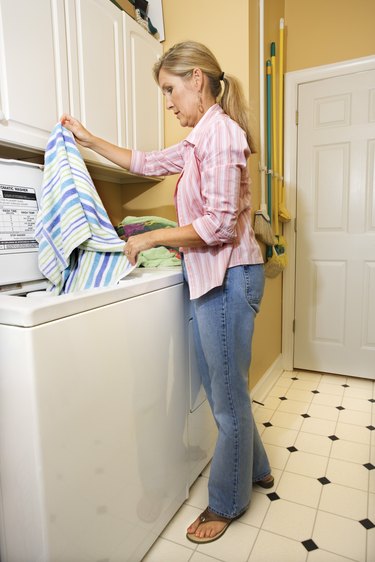
Squeaking from your top-load washing machine may indicate an easily resolved problem, such as something caught inside or a dirty valve screen. It may also be a warning that your machine needs repair. If the machine is in good condition and has been properly maintained, a squeaking noise can often be repaired without a call to a technician.
New Machine
Video of the Day
Squeaking in a new washing machine is not uncommon. GE recommends allowing your machine to work through about five complete wash cycles. The squeak should disappear as the machine works through this initial "break-in" period. If the squeak develops in an older model, however, it may mean that a part is worn or broken.
Video of the Day
Loose Objects in Tub
Hard objects such as pens, bra wires or buttons that get stuck in the washing machine tub can produce a squeaking noise as the machine runs. Typically, this is heard during the spin cycle. The object may be stuck beneath the agitator where you can't see it. Inspect the tub, and check the manufacturer's instructions for removing your washer's agitator. In most models, there is a bolt in the top of the agitator that must be removed; then, the top half can be lifted off. Remove the second bolt to remove the bottom portion, and you'll have a clear view of anything that might have slipped beneath the base.
Wash and Spin Cycle Squeaks
Some top-load washers use a direct-drive system, which means that the motor and transmission are connected by a coupler. This coupler is made of plastic and rubber and acts like a belt. Eventually it can wear and break, and this can result in a squeaking noise during the wash and spin cycles. In other models that don't use a direct drive system, a worn or dusty brake stator can cause a squeaking noise as your machine cycles. Typically, these problems won't affect the normal operation of the washing machine, but the noise can become quite loud, so replacing or repairing these parts is recommended.
Squeaks While Filling
Squeaks or squealing noises while your top-load washer is filling indicate that the water pressure is too high. Adjust your hot and cold water valves, and try to fill the machine again. If the noise decreases, then the water pressure of your home plumbing is too high. To correct this, you'll have to contact a plumber. If this does not lessen the squeak, it may be the water valve screens that are causing the problem. To check these, unplug your machine and turn off the water supply to the valves. Remove the hoses from the back of your machine, and place them into a bucket. Where the hoses were connected to the machine is where you'll find the water valve. Inside these connections are the screens, which can usually be pried out gently with a flat-head screwdriver. If they're plastic, try to remove them with needle-nose pliers. If the screens are damaged, replace them. If they're just dirty, clean them with warm water, scrubbing away deposits with a soft toothbrush. Reinstall the screens, and attach the hoses once more. Turn the water on, and try to fill the machine again. If the valve is your problem, then the squeak should stop.